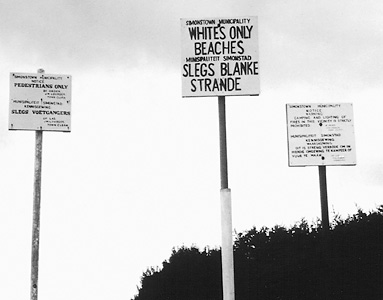Racism is the belief that human beings can be divided into races and that members of some races are inferior to members of other races. People who believe in racism are called racists. They claim that members of their own race are mentally, physically, morally, or culturally superior to those of other races. Because of this, racists feel they deserve special rights and privileges. Racism in most countries has been directed mainly by the majority population group against ethnic minority groups. These minorities have faced discrimination in such areas as housing, education, and employment.
Although no scientific proof supports racist claims, racism is widespread and has caused major problems throughout the world. Racism is most often used to justify the creation of political or economic systems that encourage or maintain the domination of one racial group over another. Claims of racial superiority have supported discrimination, segregation, colonialism, slavery, and even mass murder.
Racism is a form of prejudice. Many people tend to consider their own appearance and behavior as normal and therefore desirable. They may distrust or fear people who look or act different. People often view other groups in terms of stereotypes. That is, they have oversimplified, preconceived, and generalized beliefs about the members of these groups.
Types of racism.
Sociologists distinguish between individual and institutional racism. Individual racism refers chiefly to the prejudicial beliefs and discriminatory behavior of individuals in relation to other ethnic groups. It is based on racial assumptions of superiority and inferiority. Individual racism is often conscious and intentional. When a person is influenced by racist assumptions but is unaware of this influence, it is considered unconscious racism.
Institutional racism refers to the policies that restrict the opportunities of minorities in communities, schools, businesses, and other group settings. Institutional racism may or may not be intentional, but it can produce harmful results. For example, a company may hire only college graduates for work that does not require a college degree. But if a smaller number of Black people than white people possess degrees, this company policy would limit the opportunities available to Black people.
Another example of institutional racism is the reported use of racial profiling in law enforcement. Racial profiling refers to the practice of using skin color as a basis for stopping people for police encounters, such as traffic checks. In the United States, some states have passed laws against the practice.
Systemic racism is institutional racism that has become manifest in many areas of society over many generations. It can be manifested, for example, as patterns of residential segregation; as a high presence of minorities in the criminal legal system; or as differences in public school budgets, in access to higher education, in career opportunities, in wages, and in banks’ lending policies in regard to people of different races.
Systemic racism occurs as a cycle with interrelated parts that reinforce one another. For example, racial discrimination can lead to minorities living in poor residential areas. Low tax revenues in such areas can result in poorly funded local schools. Students who attend such schools may have limited opportunities to attend college or get a good job. It can be extremely difficult for minorities to escape such a cycle.
In a way, systemic racism is like a deeply rutted trail for racist thoughts, actions, and institutions. As more “wagons” travel the trail, the ruts grow deeper and it becomes more difficult to travel outside of them. Thus, racial prejudice, discrimination, economic and social inequalities, and injustice persist and thrive. This dynamic supports a system in which one racial group in a society dominates others.
Environmental racism, also called environmental injustice, results when individual or institutional racism produces harmful environmental effects on a group. Environmental racism can occur, for example, when members of a minority group are forced to live near a toxic waste dump due to a lack of housing elsewhere.
History.
The idea of biological determinism became widespread in Europe during the 1700’s. Biological determinism is the idea that a person’s biological makeup determines his or her intelligence and behavior. This belief led to the development of racism as Europeans began to spread out around the world.
From the 1700’s to the early 1900’s, Europeans gained control of large parts of Asia and Africa. These colonialists justified their domination on the grounds that the black-, brown-, and yellow-skinned people had to be “civilized” by the “superior” white people. By the mid-1900’s, most colonialism had ended, but its effects on the world are still felt today. For details, see Africa (History); Asia (Results of colonialism); Asia (The spread of Communism).
From the 1600’s to the mid-1800’s, many white people in the United States held Black people in slavery. The enslaved people were freed during the 1860’s, but segregation and discrimination against African Americans continued. In the 1960’s, the U.S. government passed laws designed to give equal opportunities to Black people. Even so, racial problems—which began with slavery and were fostered by discrimination and segregation—continue to plague the United States.
Genocide is the deliberate and systematic mistreatment or extermination of an entire people. It is the most extreme result of racial hatred. Genocide was widely practiced by European settlers against the local peoples in Africa and the Americas. Adolf Hitler, the ruler of Nazi Germany, preached that Germans belonged to the “superior Aryan race,” and that Jews and other non-Aryans were inferior. Hitler’s racist beliefs resulted in the murder of millions of Jews and others during the 1930’s and 1940’s. See Jews (Beginnings of Nazi persecution).

In the late 1940’s, the government of South Africa established a racial policy called apartheid. It was one of the world’s most complete systems of racial separation. It called for separate institutions for white and nonwhite people and reserved about 85 percent of the nation’s land for the white minority. In 1991, South Africa repealed the last of the laws that formed the basis of apartheid. See South Africa (People); South Africa, History of (Apartheid).

The science of race.
Groups, as well as individuals, differ. But there is no scientific evidence to support claims of superiority or inferiority based on these differences. Social scientists emphasize that no two groups have exactly the same environment. As a result, many group differences are largely the result of different environments.
Scientists have long debated the relative importance of heredity and environment in determining differences among people. Most anthropologists today reject the idea that human beings can be divided into races based on biological differences alone. Instead, race is understood to be a complex concept that involves many other factors, such as environment and social behavior. For a discussion of these ideas, see Intelligence (The roles of heredity and environment) and Races, Human (Race and discrimination).
